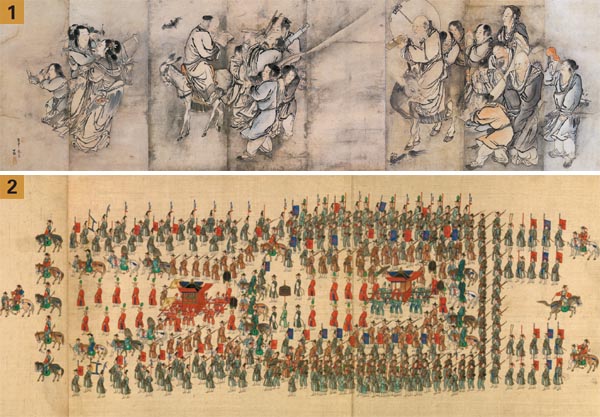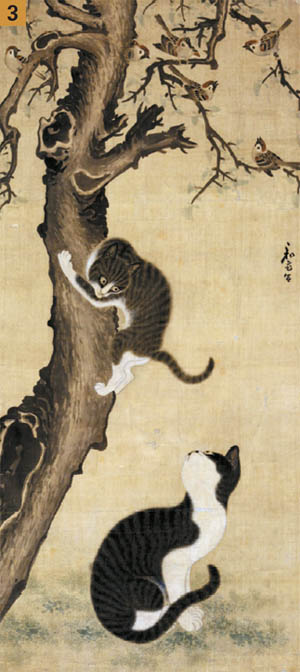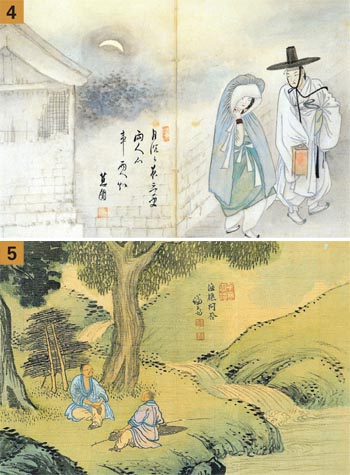Splendid colors in scenes of the everyday

“The Court Painters of Joseon Dynasty” show at Leeum features: 1. “Immortals” (1776) by Kim Hong-do, 2. “Royal Palanquin Procession” by a 19th-century anonymous court painter and 3. “Cats and Sparrows” by Byeon Sang-byeok in the 18th century.
In the Joseon Dynasty (1392-1910), muninhwa, or simple paintings with philosophical meanings made by aristocratic scholars, who were operating under the influence of Confucianism, were more respected than paintings by professional artists, who were generally from the lower classes.
However, it is the latter group of paintings that tend to appeal to the viewers of our time. What makes the paintings done for the court by professional artists so attractive are the splendid colors, the meticulous details in the paintings and the vivid expressions and humor in their genre paintings, which depict scenes from everyday life.
Now, two museums are holding exhibitions dedicated to such paintings. One is “The Court Painters of the Joseon Dynasty” show at Leeum, Samsung Museum of Art, in Yongsan District, central Seoul, which started Thursday. The other is the regular fall exhibition of the Kansong Art Museum in Seongbuk District, northern Seoul. The museum is open only four weeks a year - two weeks in May and two weeks in October. This show, which starts tomorrow, focuses on genre paintings and portraits.
The Leeum exhibition features about 110 paintings by hwawon, or court painters, who were responsible for the production of paintings for the state as employees of Dohwaseo, the state bureau of painting in Joseon.
“Despite their important roles and popularity, hwawon were limited to a low social status and their abilities were often regarded by the sadaebu [the aristocracy of Joseon] in the same light as the manual skills of craftsmen,” said Cho Ji-yoon, curator at Leeum.

“This sort of bias against hwawon has continued until the present,” Cho said. “There have been no exhibitions centered on them and art historians have generally relegated them as secondary or minor figures.” Cho emphasized that the Leeum exhibition is the first dedicated to hwawon.
The show is divided into two sections. The first features paintings that hwawon created for the court and royal household. Included are documentary paintings showing court events and ceremonies, portraits of kings and high-ranking officials and decorative paintings such as peony paintings for screens used at royal weddings. Most feature splendid colors, in particular, deep reds and dark greens, and elaborate brush strokes.
The highlight of the section is “Royal Palanquin Procession,” a nearly 10-meter-long painting depicting a procession of King Gojong and his family in the late 19th century. Thanks to digital devices installed nearby, viewers will be able to see the meticulous detail of numerous figures in the procession. Viewers will not, however, be able to see the king and queen, because it was not customary to depict them in such a procession.
The second section features paintings created by hwawon for private patrons, including noblemen and wealthy aristocrats.
“When they were not engaged in a court project, they accepted commissions from wealthy families,” Cho said. “In meeting their patron’s desires and creating works reflecting contemporary subjects and popular styles, they contributed to the formation of new artistic trends. A good example of this are the vivid portrayals of quotidian activities in late 18th century genre paintings.”

The fall exhibition of Kansong Art Museum features: 4. “Lovers under the Moon” by Shin Yun-bok and 5. “Conversation between a Fisherman and a Woodcutter” by Jeong Seon. Provided by the museums
This section also includes “Cats and Sparrows” by Byeon Sang-byeok (?-1775), whose nickname was “Byeon Cat” because his cat paintings were so popular.
Meanwhile, Kansong Art Museum, Korea’s oldest private museum, founded in 1938, will show 100 paintings by 52 artists.
The highlight of the exhibition will be paintings by Sin Yun-bok (1758-?), one of the two top 18th-century genre painters with Kim Hong-do. Sin focused on love affairs and life around adult entertainment areas. His paintings are far from vulgar but evoke a subtle eroticism. The show includes Sin’s famous “A Beauty” and his romantic “Lovers under the Moon.”
The exhibit also includes paintings by Ahn Gyeon and Jeong Seon (1676-1759), who was a rare professional artist from an aristocratic family. Jeong is best known for his realistic landscapes based on sketches from nature, which were revolutionary for its time. The exhibition will also show his paintings of people, including “Conversation between a Fisherman and a Woodcutter.”
*“The Court Painters of Joseon Dynasty” at Leeum runs until Jan. 29, 2012. Admission is 7,000 won ($6). Hours are 10:30 a.m. to 6 p.m. from Tuesday to Saturday. Go to Hangangjin Station, line No. 6, exit 1. Call (02) 2014-6900 or visit www.leeum.org.
The Kansong Art Museum exhibition starts tomorrow and runs to Oct. 30. Admission is free. Hours are 10 a.m. to 6 p.m. every day during the exhibition period. Go to Hansung University Station, line No. 4, exit 5 and walk 15 minutes. Call (02) 762-0442.
By Moon So-young [symoon@joongang.co.kr]
한글 관련 기사 [중앙일보]
그림으로 만나다, 얼굴 없는 조선 왕실화가 ‘화원’
리움 개관 7주년 ‘조선화원대전’
‘모월 모시 성상(聖上)께서 중전마마, 세자저하와 함께 모처로 행행(行幸)하셨다. 어물(御物·왕의 물건)을 실은 가마를 앞세우고 문무백관, 대포를 끄는 호의군사 등이 뒤따랐다. 성상의 가마 앞에는 황룡기와 태극기를 든 기수가 앞섰다. 나는 이 행렬을 따라가며 반차도(班次圖)를 남겼다.’
19세기 왕실 화가가 일지를 썼다면 이런 내용이 아니었을까. 서울 한남동 삼성미술관 리움에서 첫 공개되는 ‘동가반차도(動駕班次圖)’의 모습이 이렇다. 길이가 996㎝에 달한다. 흔히 알려진 서책 형태 의궤도(儀軌圖)와 달리 왕실 행렬의 위용을 한눈에 보여준다. 명성왕후와 세자(후에 순종), 흥선대원군 부처의 가마가 뒤따르는 걸로 봐서 고종이 대한제국을 선포하기 이전인 1883∼95년 사이에 그려진 것으로 추정된다.
리움은 13일부터 개관 7주년 기념 ‘조선화원대전(朝鮮畵員大展)’을 연다. 문인화와 함께 조선시대 회화사의 양 축을 이루는 화원화를 본격 조명한 첫 전시다. 화원은 왕실에 소속된 직업 화가. 왕의 초상, 지도, 의궤, 산수화, 불화, 그리고 18세기 후반 풍속화까지 다종 다양한 작품을 남겼다. 그러나 신분제의 질곡 속에서 몇몇 대가를 제외하고는 제대로 평가 받지 못했다.
전시는 왕의 초상화인 어진(御眞)부터 남녀간의 애정행각을 묘사한 춘화(春畵)까지, 그야말로 모든 것을 그릴 수 있었던 화원들의 작품세계를 농축해 보여준다. 총 110여 점이 나왔다. 국보 139호인 김홍도의 ‘군선도(君仙圖)’, 보물 1430호인 ‘화성능행도(華城陵行圖)’ 등 보물 12점도 있다.
고종 일가의 행차를 그린 ‘동가반차도’(부분)에는 붉은 바탕의 태극기가 등장한다. 공식 행사에 등장한 첫 태극기 그림으로 추정된다. ◆옛 그림의 디지털 연출=오늘날의 미술관·박물관은 소장품을 어떻게 보여줘 이야기를 만들 것인가에 역점을 둔다. 현대미술의 강렬함에 익숙한 관객들에게 고미술 전시가 신경 써야 할 부분이다.
전시는 ‘십장생도(十長生圖) 창호’를 지나 ‘화성능행도’와 ‘동가반차도’로 시작한다. 왕의 행렬을 따라가듯 궁 안으로 들어가는 기분을 내기 위해서다. 이렇게 궁 안에 들어가면 왕을 뜻하는 ‘일월오악도 8곡병(日月五嶽圖八曲屛)’, 순조의 마흔 살 생일잔치에 왕과 신하들이 시를 적은 ‘순조기축진찬도(純祖己丑進饌圖) 8곡병’ 등 화원이 기록한 조정의 모습이 있다. 한 층 내려가면 화원들이 궁 밖에서 개인적으로 그렸던 풍속화·산수화 등을 볼 수 있다.
당대 풍속화의 대가로 이름을 날렸던 김득신의 ‘사계풍속도(四季風俗圖)’, 조선 전기 안견의 ‘몽유도원도(夢遊桃源圖)’에 비할 이상향을 그린 이인문의 ‘강산무진도(江山無盡圖)’, 장승업의 ‘영모도대련(翎毛圖對聯)’ 등 이름난 화원들의 대표작을 모았다. 전시의 마지막은 춘화. 이 농염한 그림은 별도의 방에서 문틈으로 엿보듯 보도록 연출했다. ‘동가반차도’ ‘강산무진도’ 등 주요작은 갤럭시탭으로 부분부분 확대해 볼 수 있다. 내년 1월 29일까지. 성인 7000원. 02-2014-6900.
◆화원(畵員)=조선시대 예조 산하 관청인 도화서(圖畵署)에서 그림 그리는 일에 종사한 잡직(雜職). 궁중에 근무하며 왕실의 각종 그림 그리기 작업에 참여, 왕실의 권위와 통치이념을 시각화했다. 또한 당대 여러 화가, 후원자들과 교류하며 다양한 그림을 남겼다.










with the Korea JoongAng Daily
To write comments, please log in to one of the accounts.
Standards Board Policy (0/250자)